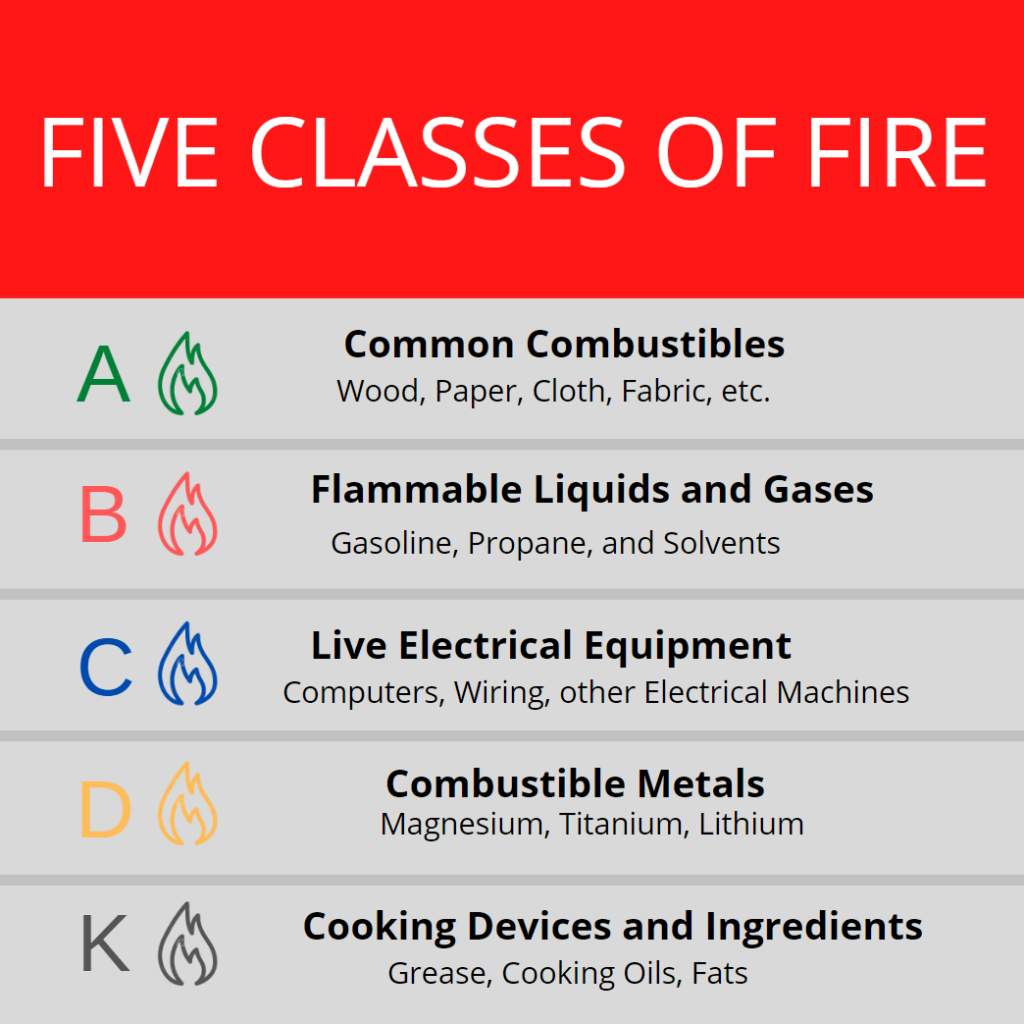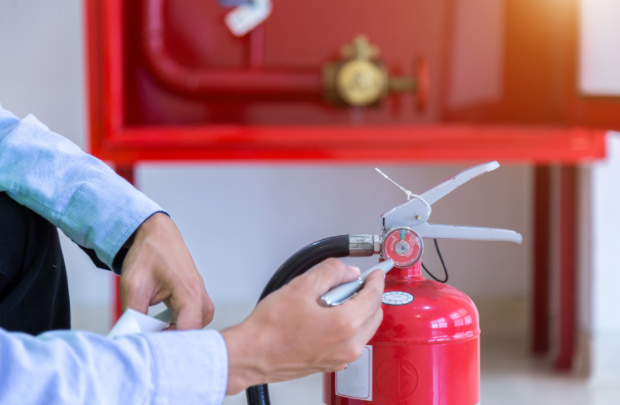Commercial fire extinguishers are an essential piece of fire protection equipment in any office, retail store, restaurant, and other commercial spaces.
However, not all commercial spaces are the same. They have different layouts, floorplans, number of occupants, fire hazards, and other important factors. So what commercial fire extinguishers does your business need?
The National Fire Protection Association lays out rules and guidelines when it comes to fire extinguishers for commercial buildings. One of the primary stipulations is that a space needs specific fire extinguishers depending on the potential class of fire that might occur in that particular location.
What You Need to Know About Commercial Fire Extinguishers
As a commercial property manager or business owner, there’s a lot of things you need to know about fire extinguishers for commercial buildings.
You need to make sure you are armed with all this necessary information so you can meet your building’s fire extinguisher needs.
Identifying Fire Hazards in Your Commercial Building

There are different kinds of fire extinguishers. Each one is built to combat a specific class of fire.
Fire classes are distinguished by what ignites the fire. Thus, you need to assess your work environment and identify potential fire sources.
Doing so will help you determine what fire class will most likely take place in your commercial space.
Classes of Fire
Different classes of fire pose a set of unique risks and hazards.
If you use a commercial fire extinguisher not built to combat a specific type of fire, you cannot help the situation; and you could do more harm than good.
Here are the different classes of fire:
Class A Fires
This class is the most common type of fire. Its fuel source are common materials such as cardboard, paper, plastic, fabric, wood, and other solids.
Almost all commercial structures have these materials within their premises. Thus, every office, retail space, and other commercial spaces is at risk for this class of fire.
Class B Fires
This class of fire involves flammable liquids and gases as the fuel source. Many of the liquids, fluids, and chemicals found in a commercial setting are flammable. These items include cleaning liquids, inks, adhesives, solvents, paints, and more.
Although this class of fire is not as common as Class A fires, it’s more hazardous than any other class. Statistics show that Class B fires accounted for 21% of losses in commercial fires in the past decade.
The best type of commercial fire extinguishers for Class B fire are those that use powder or foam to combat flames.
Class C Fires
This class of fire is ignited by live electrical equipment such as motor, wiring, electrical paneling, and more. Extinguishers built to combat Class C fires will have a clear indicator that they are for this specific class.
Never use water or dry powder fire extinguisher to kill Class C fires. You’ll only do more harm than good to your property and other business assets.
Class D Fires
Class D fires are ignited by combustible metals. These metals include sodium, magnesium, and titanium. Use extinguishers with a D rating to combat Class D fires.
If you use a fire extinguisher not designed to kill Class D fires, then you risk elevating the severity of the fire. The most effective way to kill fires caused by combustible metals is to use dry powder – and that’s exactly the primary fire killing material of D-rated fire extinguishers.
Class K Fires
Class K fires have similar characteristics with Class B fires. As mentioned above, Class B fires come from flammable liquids, gases, and petroleum products.
Substances such as vegetable and animal fats fuel Class K fires. This fire class also grows rapidly because the fuel source is cooking oils, animal fats, cooking grease, and vegetables fats – which are all highly flammable.

If your business involves a commercial kitchen such as restaurants or catering, then kitchen fires are something you should be prepared for.
As such, you should equip your business with Class K commercial fire extinguishers.
What Business Owners Need to Know About Commercial Fire Extinguishers
If you are a commercial property manager or a business owner, you most likely have equipped your building with at least one fire extinguisher in case of a fire emergency.
While extinguishers are relatively easy to operate, there are several important things you need to know. In particular, business owners are not particularly aware of the vital things required to keep a good fire protection system in place. All these important things are fundamental in keeping your commercial structure safe.
We consulted with some local fire protection companies about some common questions about commercial fire extinguishers. We hope this information keeps you well informed about ensuring a good fire safety system for your business.
There Are Multiple Types of Extinguishers
There are several different types of fire extinguishers. Each type has its own differing qualities built for a specific class of fire. You can’t put out a metal, electrical, or grease fire in the exact same method.
Therefore, you’ll need the right type of fire extinguisher in your commercial setting to ensure effective use.
Fire Extinguishers Require Regular Inspection and Maintenance
Installing a fire extinguisher in your office, retail space, or restaurant is not enough. The NFPA mandated that extinguishers should be frequently inspected, serviced, and maintained.

A professional fire extinguisher provider must inspect your devices for at least one year. On top of that, OSHA compels a monthly comprehensive visual inspection.
You, as the property manager or business owner, should do these inspections. If not you, you should assign a member of your staff to fulfill this requirement.
Recharging Fire Extinguishers Is Crucial
If you have rechargeable fire extinguishers throughout your commercial facilities, make sure you refill the canister every time you activate the device. This practice ensures that the fire protection equipment is always ready for deployment in case of an emergency.
Extinguishers Don’t Last Forever
If you have no recollection of when the fire extinguishers in your commercial building were last replaced, serviced, inspected, or maintained, then it’s time to get new ones.
While rechargeable canisters of commercial fire extinguishers don’t technically have an expiration, they need to pass a hydro-testing every 12 years. On top of that, disposable canisters must also be replaced every decade.
Types of Fire Extinguishers for Commercial Buildings
To maximize the use of commercial fire extinguishers, you should consult with a professional fire protection company.
They are professionals who can help you meet the specific fire safety needs of your commercial establishment.
Here are the types of fire extinguishers you can use for your business.
ABC Dry Chemical Extinguishers
This is a type of extinguisher that you can use to put out Class A, B, and C fires. It’s equipped with a special powdered material that helps kill fires fueled by common combustible solids, flammable liquids, gases, and electrical fires.
However, the extinguishing agent used in this type of extinguisher is corrosive. Thus, it should be immediately cleaned up after discharging the device.
Class ABC fire extinguishers are ideal for most types of office buildings, retail spaces, and other types of commercial establishments.
Water Mist
This type of fire extinguisher is a suitable option for commercial settings equipped with sensitive devices and equipment. A water-based extinguisher can put out fire without the corrosive extinguishing agent so that it won’t damage any office equipment.
This type of extinguisher is ideal for hospitals and other commercial settings with expensive appliances and machinery. Water mist extinguishers can safely and effectively combat fires without damaging sensitive pieces of equipment.
Class K Wet Chemical
This type of commercial fire extinguishers is commonly used in restaurants, catering businesses, and other commercial kitchen settings. ABC fires can’t combat grease fires, which are classified under Class K fires.
Class K extinguisher is built specifically to combat kitchen fires. They can reach up to 12 feet with a rate between 30 and 80 seconds.
CO2 Fire Extinguishers
This type of fire extinguisher removes the oxygen and heat elements from fire using a cold carbon dioxide discharge. It’s perfect for extinguishing fires under Class B and C. However, you can’t use CO2 extinguishers on metal-caused fires.
The maximum distance that CO2 extinguishers can reach is 8 feet with a discharge time of up to 30 seconds. Remember not to use this type of fire extinguisher in small and unventilated spaces.
Metal/Sand Fire Extinguishers
This type of extinguisher utilizes sodium chloride to kill fires under the Class D category. As mentioned above, Class D fires are fueled by metals such as sodium, titanium, and magnesium. Metal/sand fire extinguishers are ideal for installing in laboratory or pharmaceutical settings.
Employing Professional Help
Employ the services of a licensed fire protection company. They can help you determine the correct number, type, size, location, and placement of commercial fire extinguishers for your building.
On top of that, experts can provide you with a custom fire protection plan for your commercial building. They can ensure that all your commercial fire protection efforts are in line with local fire and safety codes.